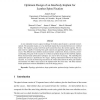Free Online Productivity Tools
i2Speak
i2Symbol
i2OCR
iTex2Img
iWeb2Print
iWeb2Shot
i2Type
iPdf2Split
iPdf2Merge
i2Bopomofo
i2Arabic
i2Style
i2Image
i2PDF
iLatex2Rtf
Sci2ools
AES
2005
Springer
2005
Springer
Optimum design of an interbody implant for lumbar spine fixation
A new minimally invasive surgical technique for lumbar spine fixation is currently in development. The procedure makes use of an interbody implant that is inserted between two vertebral bodies. The implant is packed with bone graft material that fuses the motion segment. The implant must be capable of retaining bone graft material and supporting spinal loads while fusion occurs. The different load conditions analyzed include: compression, flexion, extension, and lateral bending. The goal of this research is to obtain an optimum design of this interbody implant. Finite element-based optimization techniques are used to drive the design. The multiobjective optimization process is performed in two stages: topology optimization followed by shape optimization. As a result, the final design maximizes the volume allocated for the bone graft material and maintains von Mises stress levels in the implant below the stress limit. The finite elementbased optimization software GENESIS is used in the...
| Added | 15 Dec 2010 |
| Updated | 15 Dec 2010 |
| Type | Journal |
| Year | 2005 |
| Where | AES |
| Authors | Andrés Tovar, Shawn E. Gano, James J. Mason, John E. Renaud |
Comments (0)

